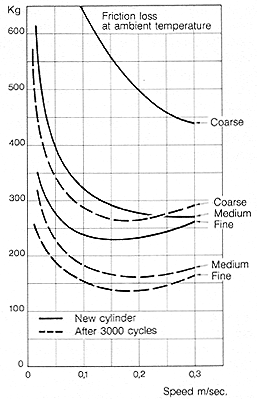Working Conditions
FRICTION
Friction is derived from an elastic material sliding against a metal surface in a normal seal application. The theory given for two rigid surfaces sliding is elementary in comparison to the complicated theory for a flexible material and a rigid surface sliding. The nature of the surface and the surface finish of the sliding parts is very important. A metal surface can have a certain roughness which will cause remarkable friction. The friction loss when working at a constant speed is shown on the graph, and details three surface finishes when new and after 3000 cycles. Another factor influencing friction is temperature. During temperature variations, the mechanical characteristics of the seal material and the fluid viscosity both change. When the temperature rises the fluid viscosity decreases, and therefore high levels of friction occur at high temperatures, due to the reduction of the oil film between the seal lip and the metal surface. In these conditions the seal is in direct contact with the roughness of the metal surface, so friction will be proportional to the surface finish.
Figure F-1 (Illustrates two surface finishes in motion, the top section is a rubber material and the lower is metal. Fa shows the resultant force of deformation. Fd shows the velocity and elasticity characteristics of the elastomer. Then between these two materials is the fluid lubricant which affects both the Fa and Fd characteristics.)


